Optimal Configuration of Power/Thermal Energy Storage for a Park-Integrated Energy System Considering Flexible Load
Abstract
:1. Introduction
- (1)
- Considering the coordinated interaction of “source-network-load-storage” and the coordinated linkage of flexible load “leveling-rotation-elimination”, a flexible load model for electric power and a flexible load model for thermal power based on the fuzziness of users’ temperature perception is proposed.
- (2)
- Using a mixed integer linear programming method, the optimal configuration scheme of the park-integrated energy system’s energy storage under specific constraints is provided, which realizes the consideration of the optimal capacity of equipment and the output benefit in each period to a certain extent.
- (3)
- The response characteristics of multi-scenario and multi-category electrothermal flexible loads participating in the optimal allocation of the park-integrated energy system’s energy storage are analyzed and compared, and the causes of energy supply/consumption and cost deviation in each scenario are deeply analyzed through an example, which verifies the rationality and effectiveness of the proposed scheme.
2. Framework of Park-Integrated Energy System
3. Flexible Load Modeling Methods
3.1. Electric Flexible Load Model
3.1.1. Transferable Load
3.1.2. Translational Load
3.1.3. Reducible Load
- (1)
- The maximum duration constraint is
- (2)
- The minimum duration constraint is
3.2. Thermal Flexible Load
3.3. Energy Conversion System Model
3.3.1. Heat Pump
3.3.2. Gas Turbine
3.3.3. Energy Storage Equipment
- (1)
- The energy storage state constraint is
- (2)
- The operational characteristics are constrained as follows:
4. Optimal Allocation Model of Energy Storage
4.1. Objective Function
4.1.1. Electricity Purchase Cost and Gas Purchase Cost
4.1.2. Equipment Maintenance Cost
4.1.3. Cost of Investment
4.1.4. Compensation Cost
4.1.5. Abandoning Wind and Light Cost
4.1.6. Carbon Transaction Cost
4.2. Solving Method
5. Example Analysis Results and Discussion
5.1. Flexible Load Optimization Results
5.1.1. Optimization Results of Thermal Flexible Load
5.1.2. Optimization Results of Electric Flexible Load
5.2. Analysis of Capacity Optimization Configuration Results
6. Conclusions
- (1)
- Considering the electric/thermal flexible load, the electric/thermal system complements each other, optimizes the electric- and thermal-load curves, and obviously reduces the energy-storage capacity, thus achieving the balance between the optimal capacity of the equipment and the output benefit in each period to some extent;
- (2)
- The park-integrated energy system’s energy storage optimization strategy is proposed, in which flexible electric load can be scheduled and indoor temperature can be flexibly adjusted. Compared with the scenarios in which flexible electric load is not considered and only flexible electric load is considered, the capacity of the storage battery is reduced by 45.68% and 7.21%, the capacity of the heat storage tank is reduced by 44.99% and 22%, and the installed capacity of the fan is increased by 3.67% and 1.66%, which is beneficial to promoting the consumption of renewable energy and improving the penetration rate of renewable energy;
- (3)
- In terms of economic operation, the proposed park-integrated energy system’s energy storage optimization configuration scheme effectively reduces the equipment investment cost, gas purchase cost, and electricity purchase cost of the system, and the total economic cost is reduced by 3.78%, which is conducive to the economic and efficient operation of the park-integrated energy system.
Author Contributions
Funding
Data Availability Statement
Conflicts of Interest
References
- Zeng, B.; Zhang, J.; Yang, X.; Wang, J.; Dong, J.; Zhang, Y. Integrated Planning for Transition to Low-carbon Distribution System with Renewable Energy Generation and Demand Response. IEEE Trans. Power Syst. 2014, 29, 1153–1165. [Google Scholar] [CrossRef]
- Streckiene, G.; Martinaitis, V.; Andersen, A.N.; Katz, J. Feasibility of CHP-plants with thermal stores in the German spot market. Appl. Energy 2009, 86, 2308–2316. [Google Scholar] [CrossRef]
- Ding, T.; Venkatesh, B.; Liu, H.; Muljadi, E.; Du, P.; Freitas, W.; Nassif, A.; Bu, S.; Arani, R.; Anjos, M.F.; et al. Guest editorial: Future distribution grids and integrated energy systems (IES). IET Gener. Transm. Distrib. 2022, 16, 1473–1475. [Google Scholar]
- Abdalla, A.; Mohamed, S.; Friedrich, K.; Bucking, S.; Cotton, J.S. The impact of clustering strategies to site integrated community energy and harvesting systems on electrical demand and regional GHG reductions. Energy Convers. Manag. 2023, 288, 117151. [Google Scholar] [CrossRef]
- Zhang, X.; Shahidehpour, M.; Alabdulwahab, A.; Abusorrah, A. Optimal expansion planning of energy hub with multiple energy infrastructures. IEEE Trans. Smart Grid 2015, 6, 2302–2311. [Google Scholar] [CrossRef]
- Moeini-Aghtaie, M.; Dehghanian, P.; Fotuhi-Firuzabad, M.; Abbaspour, A. Multiagent genetic algorithm: An online probabilistic view on economic dispatch of energy hubs constrained by wind availability. IEEE Trans. Sustain. Energy 2014, 5, 699–708. [Google Scholar] [CrossRef]
- Bach, P.F. Towards 50% wind electricity in denmark: Dilemmas and challenges. Eur. Phys. J. Plus. 2016, 131, 161. [Google Scholar] [CrossRef]
- Lu, X.; McElroy, M.B.; Peng, W.; Liu, S.; Nielsen, C.P.; Wang, H. Challenges faced by China compared with the US in developing windpower. Nat. Energy 2016, 1, 16061. [Google Scholar] [CrossRef]
- Norouzi, F.; Karimi, H.; Jadid, S. Stochastic electrical, thermal, cooling, water, and hydrogen management of integrated energy systems considering energy storage systems and demand response programs. J. Energy Storage 2023, 72, 108310. [Google Scholar] [CrossRef]
- Jiang, J.W.; Hong, D.D.; Xiao, L.Q. Cost-based site and capacity optimization of multi-energy storage system in the regional integrated energy networks. Energy 2022, 261, 125240. [Google Scholar]
- Feng, P.L.; Wei, W.; Jun, W.; Da, L.; Chuan, L.; Wen, Y.C. Optimal Operation Model of Park Integrated Energy System Considering Uncertainty of Flexible Electrical, Thermal and Gas Load. J. Phys. Conf. Ser. 2021, 1, 2095. [Google Scholar]
- Yang, K.X.; Ying, C.; Zi, L.; Lin, Z.L. Low-carbon economic optimal dispatch of integrated energy system considering flexible load. Renew. Energy Resour. 2019, 37, 1206–1213. [Google Scholar]
- Zou, C.; Cui, X.; Zhou, B.; Gao, J.; Liu, Y. Optimal dispatch of combined heat and power system considering flexible load and electric boiler under carbon trading environment. Electr. Meas. Instrum. 2019, 56, 34–40+56. [Google Scholar]
- Liu, R.; Li, Z.; Yang, X.; Sun, G.P.; Li, L.H. Optimal Dispatch of Community Integrated Energy System Considering User-Side Flexible Load. Acta Energiae Solaris Sin. 2019, 40, 2842–2850. [Google Scholar]
- Setlhaolo, D.; Xia, X.; Zhang, J. Optimal scheduling of household appliances for demand response. Electr. Power Syst. Res. 2014, 116, 24–28. [Google Scholar] [CrossRef]
- Chun, Y.J.; Yu, C.Z.; Jia, J.X. Integrated energy collaborative optimal dispatch considering human comfort and flexible load. Electr. Power Autom. Equip. 2019, 39, 254–260. [Google Scholar]
- Rasheed, M.; Javaid, N.; Ahamd, A.; Khan, Z.A.; Qasim, U.; Alrajeh, N. An efficient power scheduling scheme for residential load management in smart homes. Appl. Sci. 2015, 5, 1134–1163. [Google Scholar] [CrossRef]
- Yang, L.; Huang, K.; Kong, X.; Lv, X.; Guo, H. Capacity Optimization Configuration of Grid-Connected Microgrid System Considering Flexible Load. Acta Energiae Solaris Sin. 2021, 42, 309–316. [Google Scholar]
- Liu, Y.; Wang, J.; Yang, H.; Li, Y.; Xie, W. Dynamic Optimal Method of Distribution Network in Consideration of Flexible Load Adjustment Capability. High Volt. Eng. 2021, 47, 73–80. [Google Scholar]
- Fei, J.; Yuan, X.; Shi, M.; Xu, Q.; Xiao, Y. Multi-Objective Optimal Strategy for the Coordination Control between Distributed Energy Storage System and Flexible Load. In Proceedings of the 2019 IEEE Innovative Smart Grid Technologies—Asia (ISGT Asia), Chengdu, China, 21–24 May 2019; pp. 1711–1715. [Google Scholar]
- Shao, S.; Pipattanasomporn, M.; Rahman, S. Development of physical-based demand response-enabled residential load models. IEEE Trans. Power Syst. 2013, 28, 607–614. [Google Scholar] [CrossRef]
- Sharma, I.; Dong, J.; Malikopoulos, A.A.; Street, M.; Ostrowski, J.; Kuruganti, T.; Jackson, R. A modeling framework for optimal energy management of a residential building. Energy Build. 2016, 130, 55–63. [Google Scholar] [CrossRef]
- Wei, H. Capacity Optimization of Community Integrated Energy System Considering Electric-Thermal Flexible Load; Yanshan University: Qinhuangdao, China, 2022. [Google Scholar]
- Qiang, R.J.; Zhao, G.M.; Chao, X.Z. Low Carbon Economic Dispatch Method of Electricity Gas Integrated Energy System Considering Flexible Load. Ind. Heat. 2022, 51, 36–40. [Google Scholar]
- Pirouti, M. Modelling and Analysis of a District Heating Network. Ph.D. Thesis, Cardiff University, Cardiff, UK, 2013. [Google Scholar]
- Nielsen, M.G.; Morales, J.M.; Zugno, M.; Pedersen, T.E.; Madsen, H. Economic valuation of heat pumps and electric boilers in the Danish energy system. Appl. Energy 2015, 167, 189–200. [Google Scholar] [CrossRef]
- Sjodin, J.; Henning, D. Calculating the marginal costs of a district- heating utility. Appl. Energy 2004, 78, 1–18. [Google Scholar] [CrossRef]
- Jiang, W.; Yan, Z.; Cao, J.; Xu, X.Y. Multiobjective comprehensive optimal dispatch of energy hub considering flexible load. Electr. Meas. Instrum. 2018, 55, 31–39. [Google Scholar]
- Sun, C.; Wang, L.J.; Xu, H.L. An interaction load model and its application in microgrid day-ahead economic scheduling. Power Syst. Technol. 2016, 40, 2009–2016. [Google Scholar]
- Lin, F.; Yi, J. Optimal operation of a CHP plant for space heating as a peak load regulating plant. Energy 2000, 25, 283–298. [Google Scholar] [CrossRef]
- Guotai, Z.; Hao, L.; Baoguo, Z.; Bangxu, W.; Wei, T. Comprehensive optimization of electrical/thermal energy storage equipments for integrated energy system near user side based on energy supply and demand balance. Power Syst. Prot. Control 2018, 46, 8–18. [Google Scholar]
- Xu, Q.S.; Li, L.; Cai, J.L.; Luan, K.N.; Yang, B. Day-ahead optimized economic dispatch of CCHP multi-microgrid system considering power interaction among microgrids. Autom. Electr. Power Syst. 2018, 42, 36–44. [Google Scholar]
- Liu, D.C.; Ma, H.R.; Wang, B.W.; Gao, W.; Wang, J.; Yan, B. Operation optimization of regional integrated energy system with CCHP and energy storage system. Autom. Electr. Power Syst. 2018, 42, 113–120. [Google Scholar]
- Lin, L.; Gu, J.; Wang, L. Optimal Dispatching of Combined Heat-power System Considering Characteristics of Thermal Network and Thermal Comfort Elasticity for Wind Power Accommodation. Power Syst. Technol. 2019, 43, 3648–3655. [Google Scholar]
- GB/T 18049-2000; Moderate Thermal Environments—Determination of the PMV and PPD Indices and Specification of the Conditions for Thermal Comfort. The State Bureau of Quality and Technical Supervision, PRC: Beijing, China, 2000.

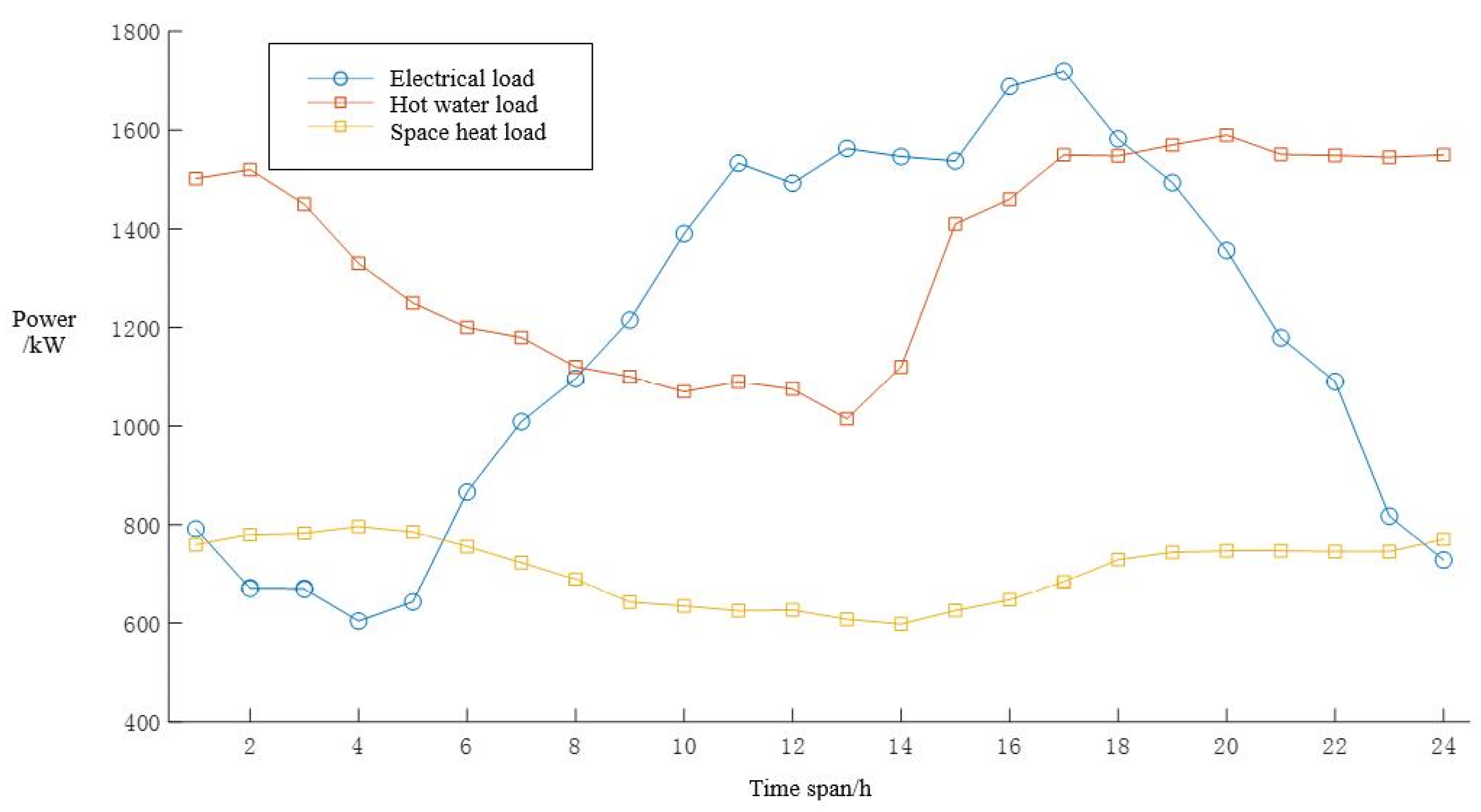
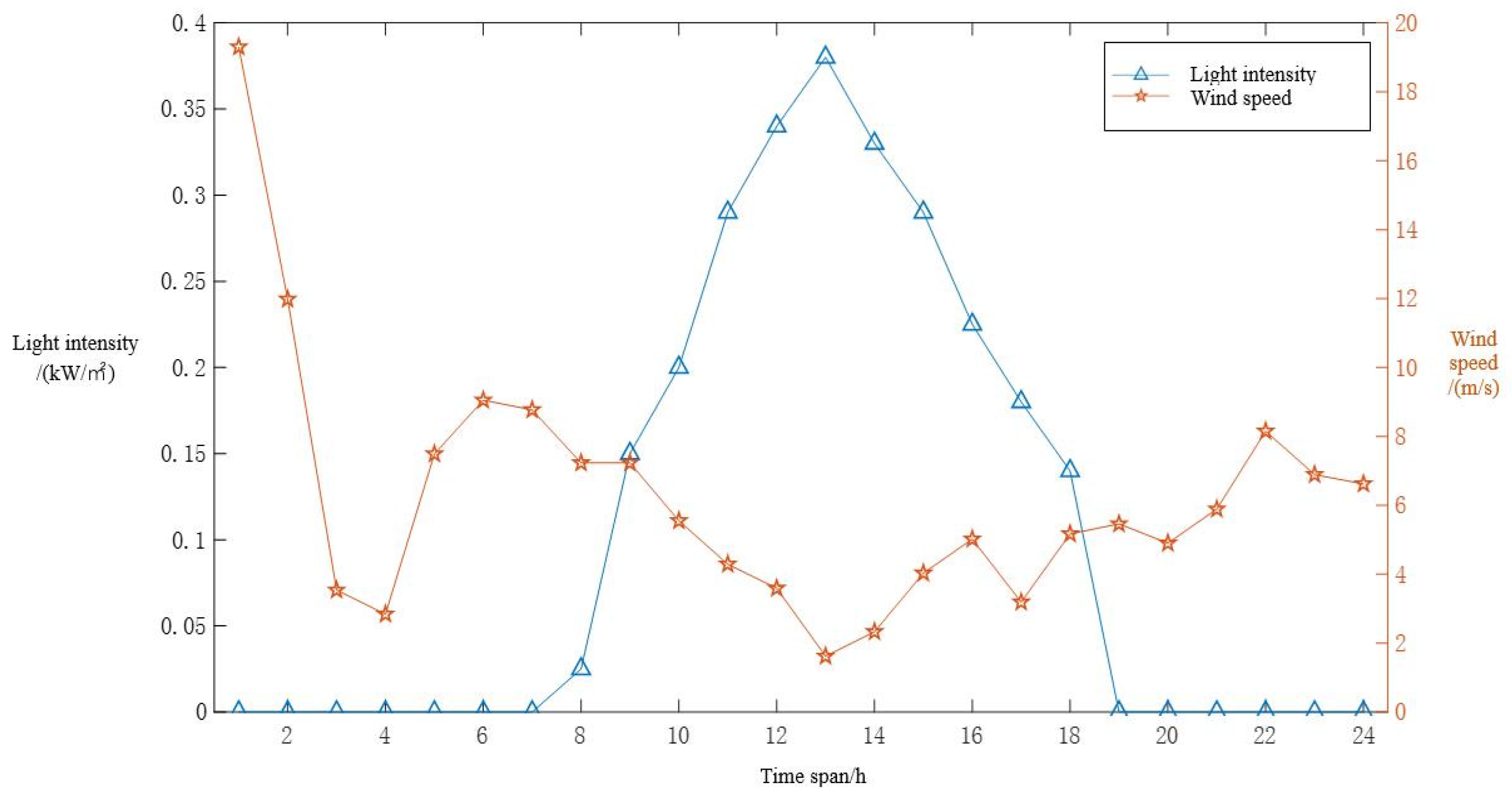

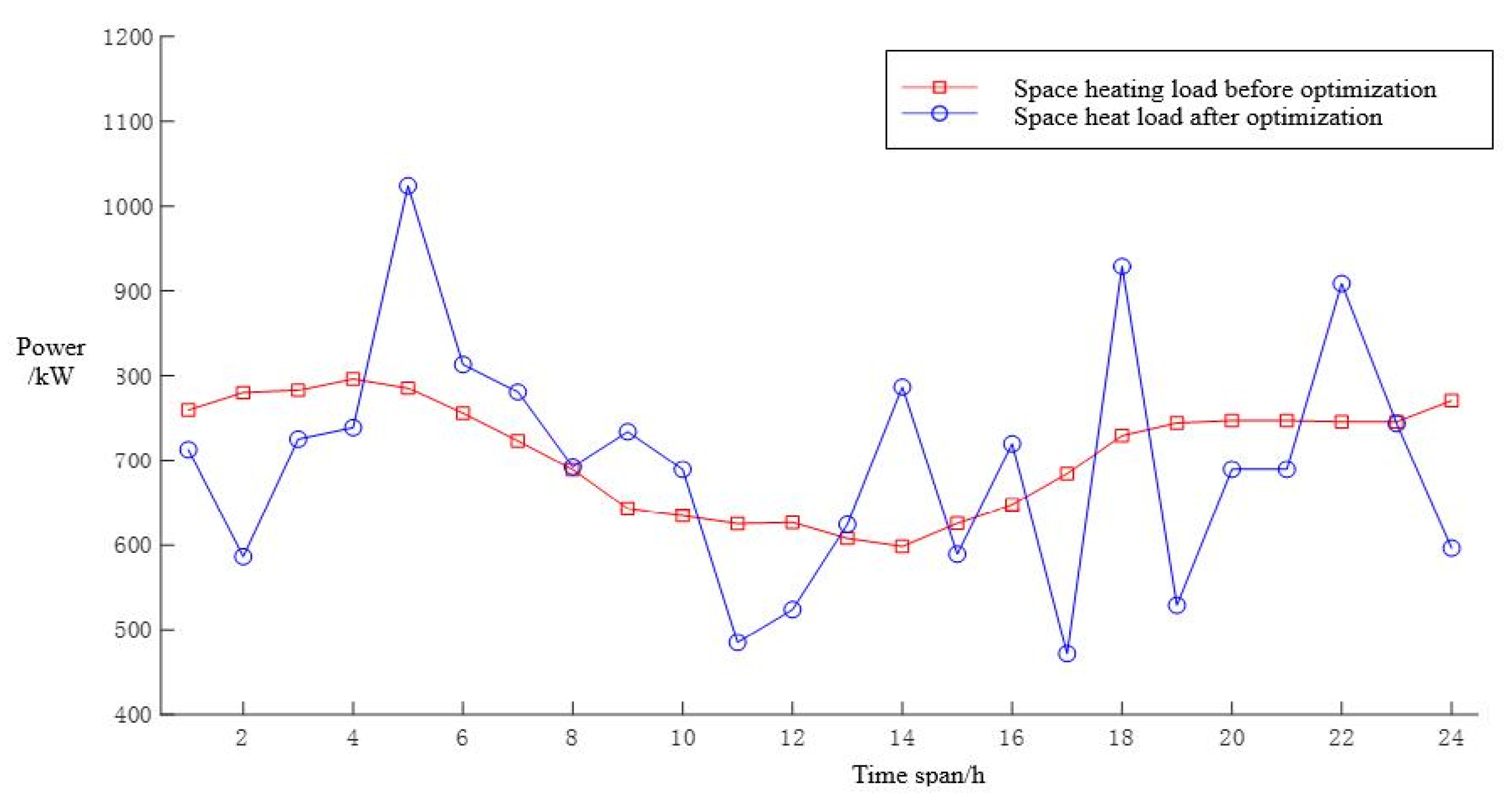
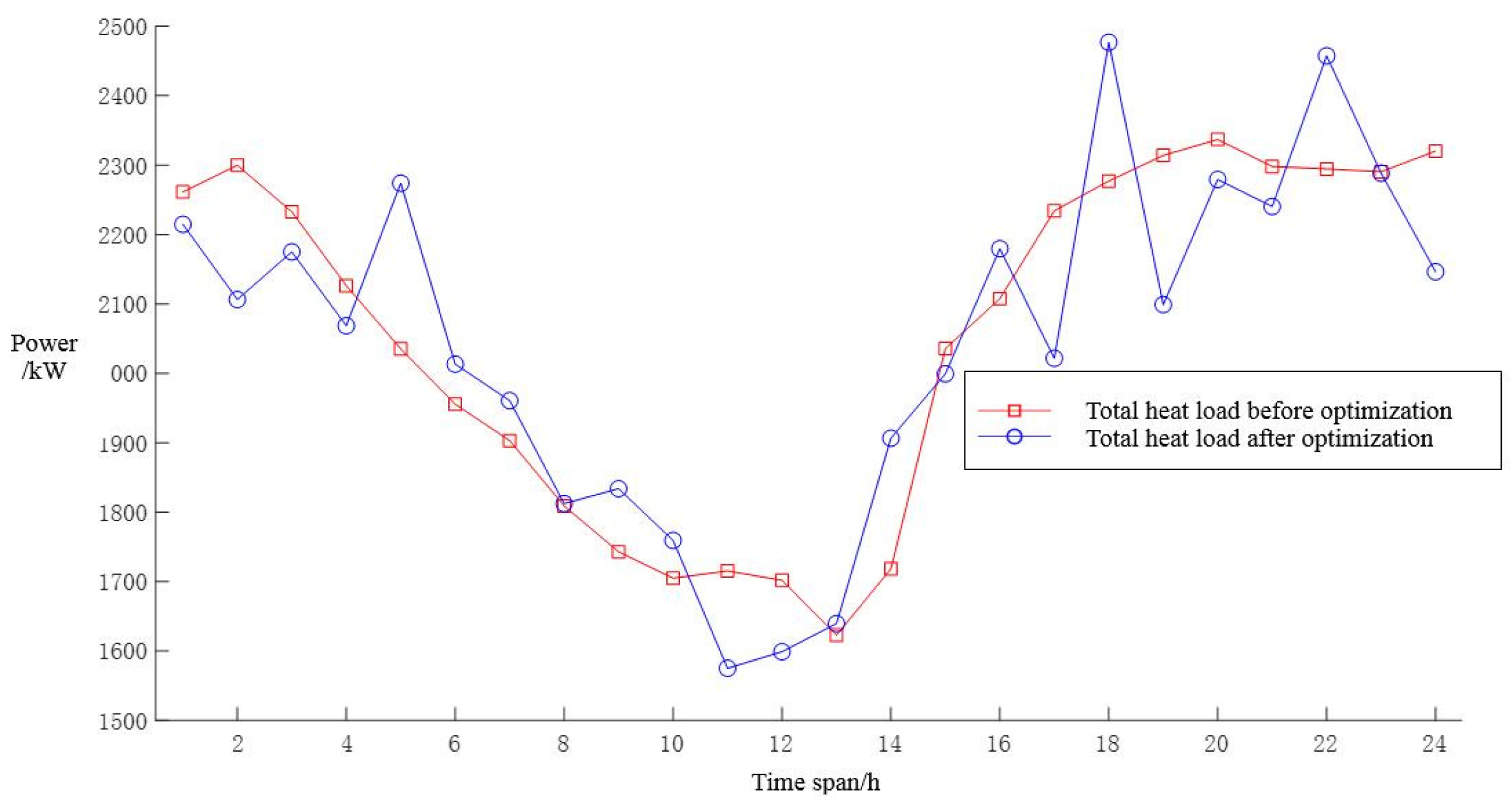

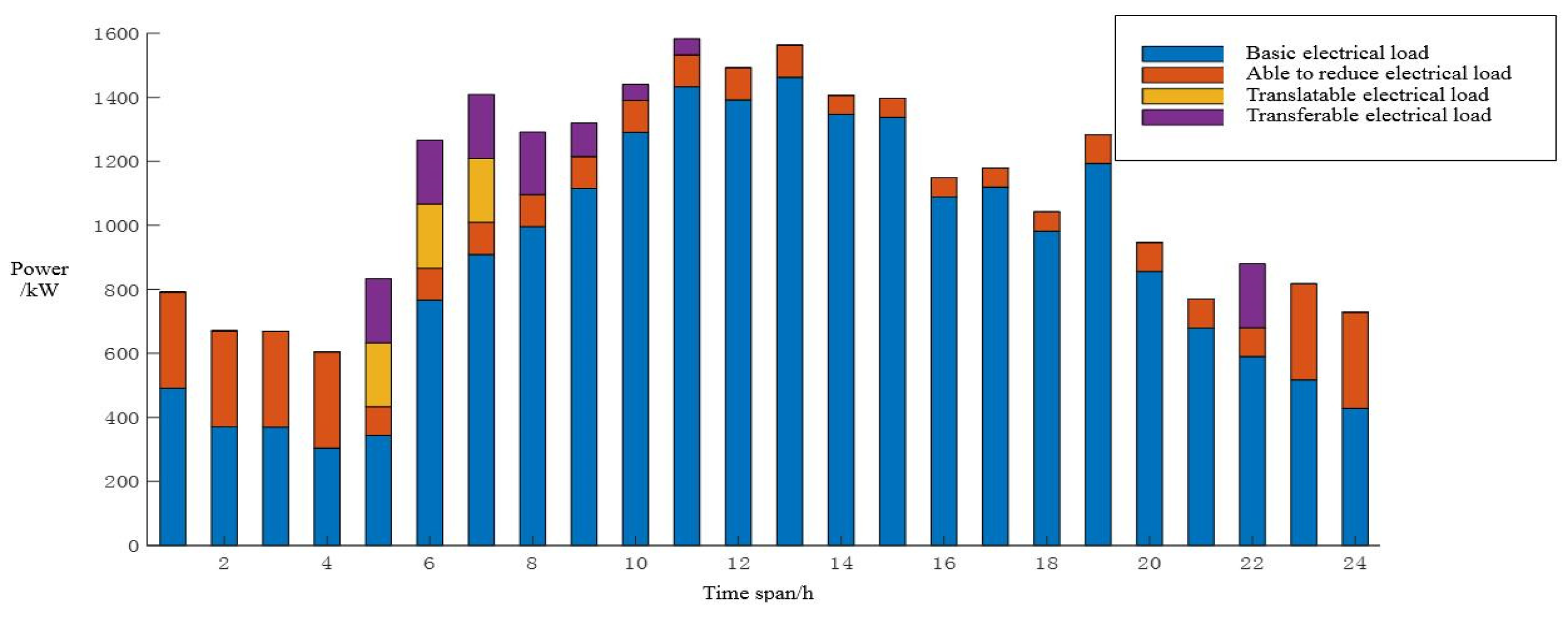
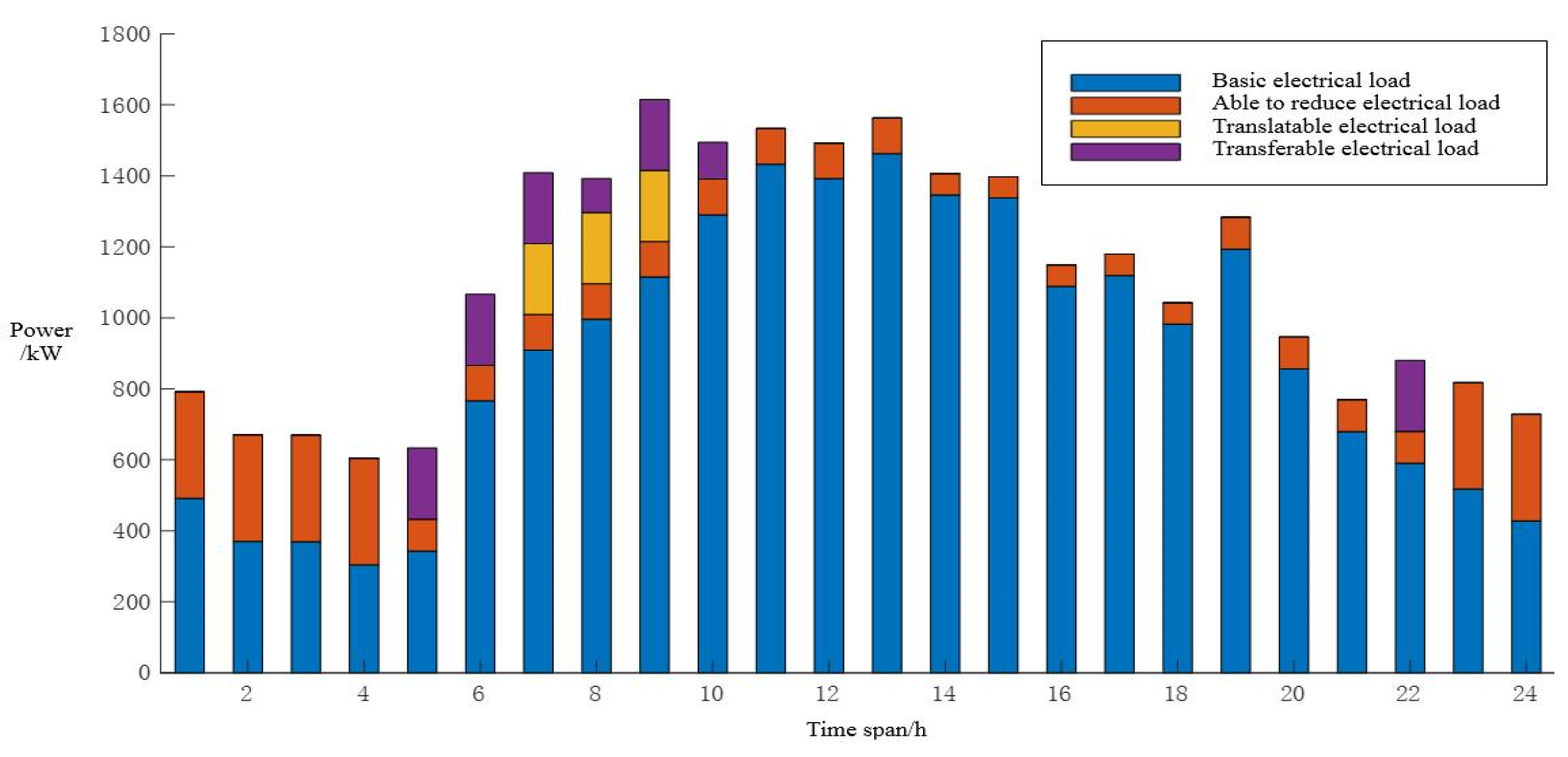
| Type | Lower Power Limit /kWh | Upper Power Limit /kWh | Operating Cost /(Yuan/kWh) |
|---|---|---|---|
| Large power grid | - | - | TOU electricity price |
| Wind turbine | 0 | predicted value | 0.52 |
| PV | 0 | predicted value | 0.72 |
| Combustion gas turbine | 0 | 200 | 2.5 |
| Time Interval | Electricity Price/(Yuan/kWh) |
|---|---|
| 10:00–15:00, 18:00–21:00 | 1.2 |
| 7:00–10:00, 15:00–18:00, 21:00–23:00 | 0.8 |
| 23:00–7:00 | 0.4 |
| Configuration Type | Scenario 1 | Scenario 2 | Scenario 3 | Scenario 4 |
|---|---|---|---|---|
| Energy storage equipment | — | √ | √ | √ |
| Electric flexible load | — | — | √ | √ |
| Thermal flexible load | — | — | — | √ |
| Scene | PV /kW | Wind Turbine /kW | Gas Turbine/kW | Electric Boiler/kW | Storage Battery/kW | Heat Storage Tank/kW |
|---|---|---|---|---|---|---|
| 1 | 778.03 | 1798.13 | 1170.90 | 1504.32 | — | — |
| 2 | 761.31 | 1932.21 | 1001.10 | 1375.80 | 1645.79 | 2559.96 |
| 3 | 758.57 | 1970.26 | 931.85 | 1415.12 | 963.51 | 1805.70 |
| 4 | 751.01 | 2003.03 | 920.66 | 1350.21 | 894.04 | 1408.36 |
| Scene | 1 | 2 | 3 | 4 |
|---|---|---|---|---|
| Investment/yuan | 2,983,702 | 3,055,669 | 2,925,680 | 2,920,146 |
| Maintenance/yuan | 98,903 | 104,030 | 102,011 | 101,500 |
| Electricity purchase/yuan | 55,548 | 0 | 758 | 0 |
| Gas purchase/yuan | 2,087,700 | 2,015,500 | 1,953,200 | 1,944,000 |
| Compensation/yuan | 0 | 0 | 65,100 | 65,100 |
| Carbon trading/yuan | 21,855 | 17,839 | 23,817 | 22,317 |
| Total/yuan | 5,247,708 | 5,193,038 | 5,070,566 | 5,049,463 |
Disclaimer/Publisher’s Note: The statements, opinions and data contained in all publications are solely those of the individual author(s) and contributor(s) and not of MDPI and/or the editor(s). MDPI and/or the editor(s) disclaim responsibility for any injury to people or property resulting from any ideas, methods, instructions or products referred to in the content. |
© 2023 by the authors. Licensee MDPI, Basel, Switzerland. This article is an open access article distributed under the terms and conditions of the Creative Commons Attribution (CC BY) license (https://creativecommons.org/licenses/by/4.0/).
Share and Cite
Zhu, Z.; Wang, M.; Xing, Z.; Liu, Y.; Chen, S. Optimal Configuration of Power/Thermal Energy Storage for a Park-Integrated Energy System Considering Flexible Load. Energies 2023, 16, 6424. https://doi.org/10.3390/en16186424
Zhu Z, Wang M, Xing Z, Liu Y, Chen S. Optimal Configuration of Power/Thermal Energy Storage for a Park-Integrated Energy System Considering Flexible Load. Energies. 2023; 16(18):6424. https://doi.org/10.3390/en16186424
Chicago/Turabian StyleZhu, Zhi, Miaomiao Wang, Zuoxia Xing, Yang Liu, and Shihong Chen. 2023. "Optimal Configuration of Power/Thermal Energy Storage for a Park-Integrated Energy System Considering Flexible Load" Energies 16, no. 18: 6424. https://doi.org/10.3390/en16186424
APA StyleZhu, Z., Wang, M., Xing, Z., Liu, Y., & Chen, S. (2023). Optimal Configuration of Power/Thermal Energy Storage for a Park-Integrated Energy System Considering Flexible Load. Energies, 16(18), 6424. https://doi.org/10.3390/en16186424





